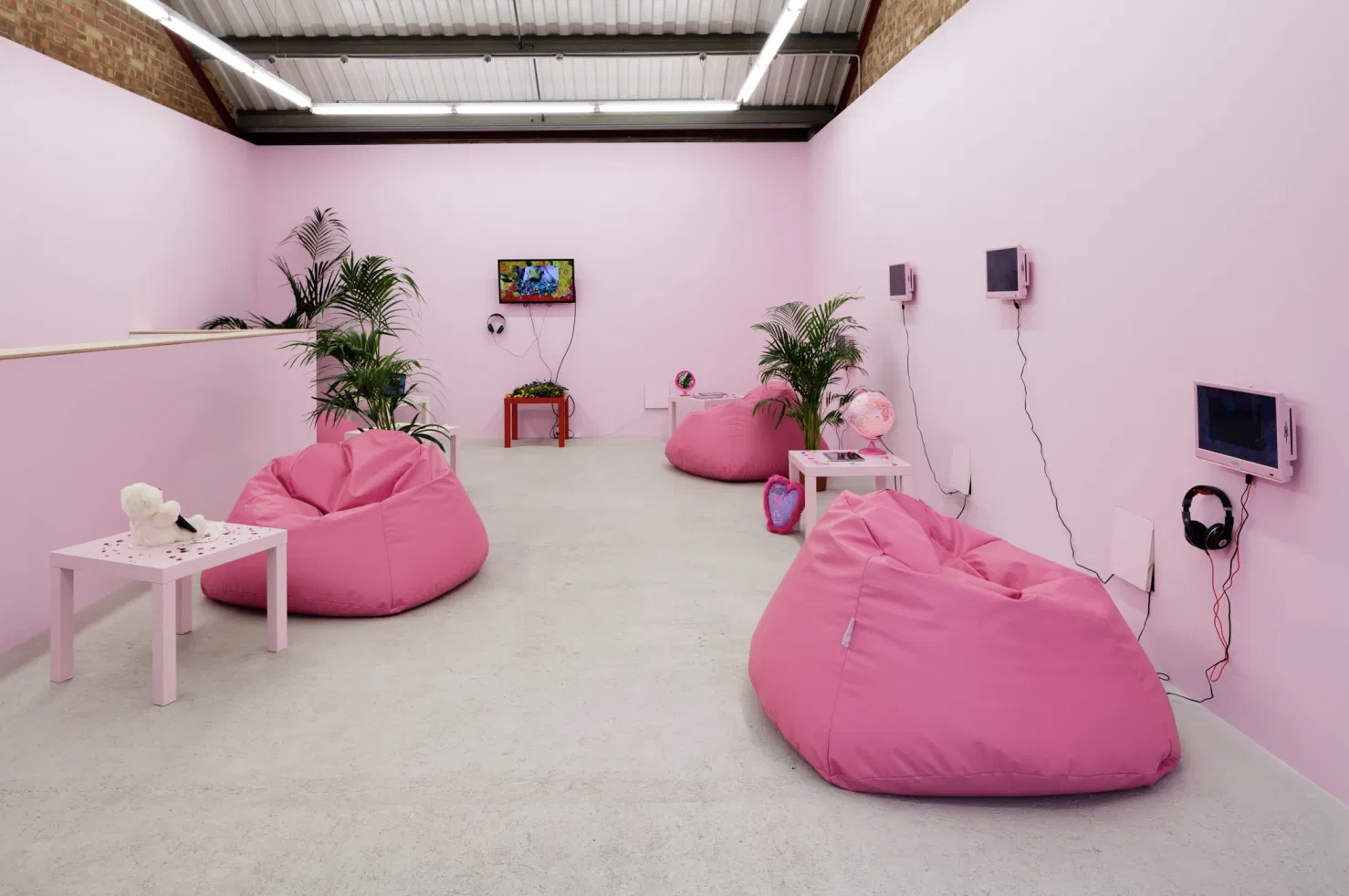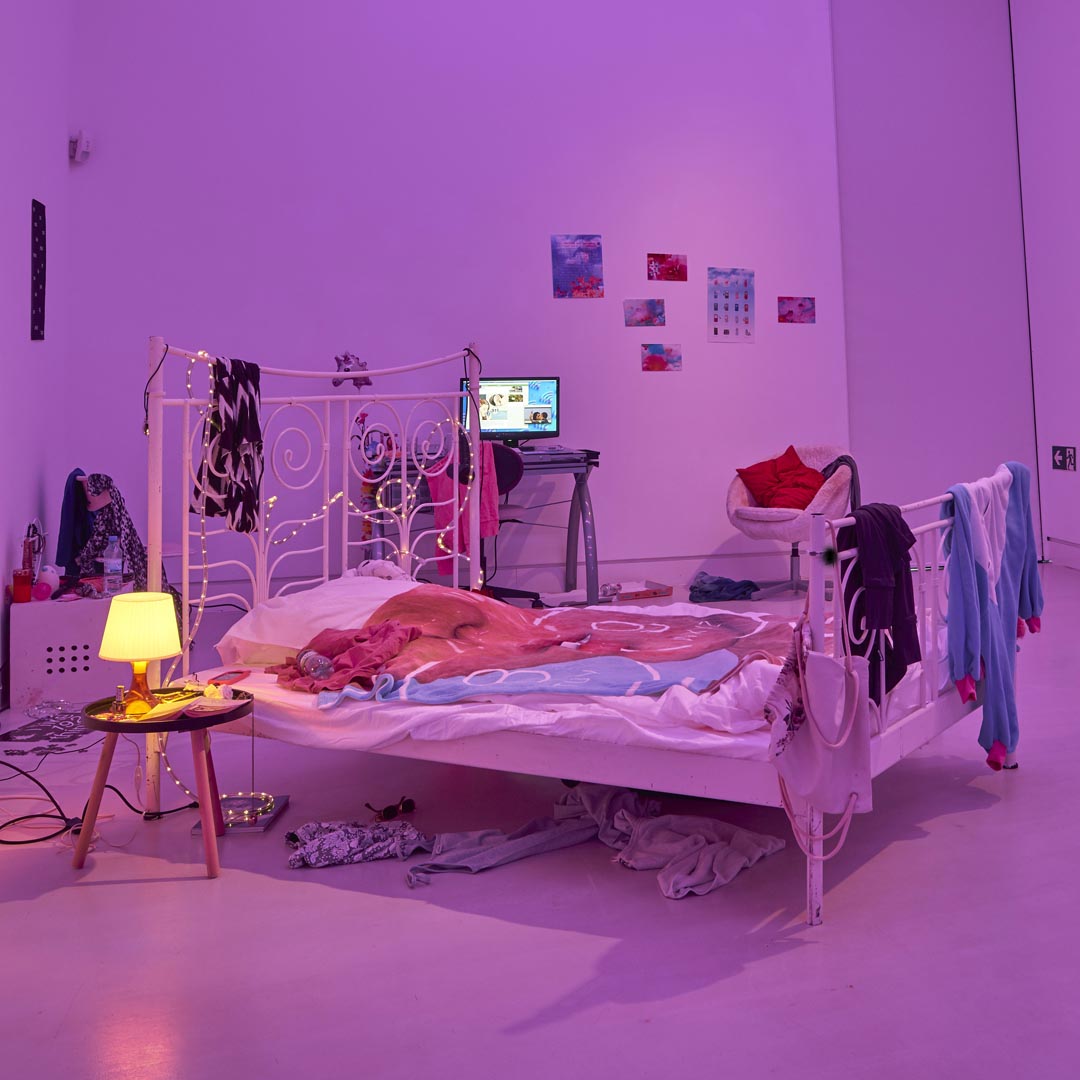


































Molly Soda has a particularly recognizable ambiance when it comes to her artwork and sense of creatively. Although many of her works resemble one another, they are clearly distinct from other professionals her age. Molly Soda, as an artist, concentrates on creating instillations that viewers can experience for themselves first hand. Not only do visitors get to explore her work through observation, we are often expected to immerse ourselves into them on a physical level. As a young Millennial herself, it seems as through the purpose behind many of her instillations is to express authentic and realistic intersectional identities. In particular, it is clear to me that via her pink aesthetic, Molly comments on feminism and female expression habitually. Additionally, Molly seems to create her own narrative regarding the digital world as a space for self-expression, connectivity, and inclusivity.
As a young woman with a messy bedroom myself, I am absolutely drawn to a vast majority of Molly’s installations and I appreciate even her still life “screenshot-like” pieces of work. To compare two of her pieces with intention, I chose to focus this paper on installations that are not only experienced by the viewer but have very similar settings. The first instillation is featured on the left of this website. Although you cannot necessarily see in this image, there are many different iPhones, computers, and iPads staged strategically around this instillation that contain images and videos of Molly expressing different emotions. This instillation is called “From my Bedroom to Yours” and it is a commentary on exposing vulnerable emotions that are usually kept in intimate spaces. To Molly, her bedroom tends to represent the most authentic version of herself. She wanted to share her most authentic self via the channel of the digital world because she believes that the internet is an appropriate place for people to feel included just like a bedroom would. By experiencing her instillation, I can tell that Molly is no different online than who she is in person because of her approach in this piece of art. A lot of people mask themselves through screens, but I believe that the purpose behind Molly’s work is to unmask these identities and create cohesive identities both away from the keyboard and in real life. This immediately reminded me of Legacy Russell’s key values. Both of these women find peace and comfort in their existence online. The difference however is that Molly is drawing these parallels to real world experiences.
As previously noted, Molly has the tendency to inspire her viewers to experience her work rather than just view it. The second piece that I would like to discuss and compare is called “Slide to Expose”. Right off the bat, it’s clear that this instillation has a very similar aesthetic to the first one. This bedroom is also mostly pink and creates an ambiance that screams femininity and vulnerability. The key differentiator here is that in order to experience this work you must pull out your phone and observe the art through the lens of your phone camera. What I mean by this is that as one is hovering their phone over parts of this bedroom set, not only do they see what their camera is capturing but additional virtual reality layers appear. The raw version of her bedroom aesthetic seems relatively happy and “normal”. However, as soon as the iPhone virtual reality addition is experienced, the viewers gain a deeper insight to the real genuine emotion Molly has. For example, there is a poster of a man who seems relatively neutral in emotion. As soon as somebody puts their phone up to his face, they can see on their screen that virtual reality tears form under his eyes. This is a creative way for Molly to comment on yet again the tendency for people to mask their true emotions. Comparably to the first instillation, Molly runs with the idea that online culture can be a place for people to feel more comfortable being themselves. Clearly, in both of her works, Molly is exposing very private settings. With this being said, I immediately thought of this quarters reading on surveillance capitalism. Large corporations frequently collect unwarranted data from media consumer and expose it without permission. Although because of this, online cultures seem very unsafe, I believe Molly is attempting to express that real-life contexts can be just as vulnerable. By looking into somebody’s bedroom you can learn an incredible amount about someone’s emotional state, habits, and true identity without speaking a word to them. Although big corporations do not have access to view our bedrooms, Molly is exposing her bedroom for the purpose of exploring these surveillance parallels.
Molly Soda is inspired by her own experiences and genuine emotions rather than being motivated by the work of a different artist. With that being said however, I did find another artist who saw beauty in an untouched bedroom. Tracey Emin is another female artist that was intrigued by the natural state of her bedroom after she recently broke up with her partner. After this tragic incident, Emin stayed in bed for days on end reusing tissues, getting drunk, binging shows, and creating a home out of her bedroom. After she finally got the emotional to strength to get up and go about her routine lifestyle, she took a moment to look back at her bed and decided it was a wonderful work of art. The purpose behind her art is to blatantly ignore and break the boundaries that society expects for women. Women are asked to perform in organized, controlled, and systematic ways. In reality, females are emotional, vulnerable, and not always put-together. Emin seems to be tired of these boundaries that society expects, and she works hard here to break these stereotypes. Even though Molly focuses quite heavily on digital cultures in relation to intimate cultures, they both value the raw expression of emotion that is oftentimes hidden. I believe that as more artists begin to emerge with contemporary pieces, the general narrative to hide our identities will fade.
As a young woman myself, these artists both introduce values into their creative instillations that I resonate with. Molly’s visual creations provided me with thought provoking insights, but I wanted to learn more about her history and intentions. Molly was born in Puerto Rico in 1989. While in her adolescence, she moved to Brooklyn in New York City for school. She rose to fame as a teenager in the early 2000s when she began blogging. Through her Tumblr, she began gaining followers and attention because of her confessions-style art and tendency to break social norms. From a young age her work concentrated on the technological mediation of self-concept. In other words, through a recent study it was determined that “social media use affects the development of an objectified self-concept over time”. Self-concept often refers to how you think and perceive your own self within society and a social world. Molly’s work also focuses on contemporary feminism (often achieved through color scheme), and cyberfeminism (achieved through the integration of screens). Both of these feminist frameworks were observed through the works that I analyzed in this paper. She also was able to gain traction through the presentation of herself in such a raw and real context online. In our order people are so used to fabricating their lives in order to fit in and gain social acceptance. It was refreshing for audiences to see someone present their authentic being and still be accepted. I believe that Molly’s hope is for people to feel more comfortable sharing their true identities in real life contexts as well as online cultures.
Form, context, and stance are three elements that describe not only the aesthetic approach, but the overall intention derived from an artist. In the case of Molly Soda both of the instillations featured on my website have very similar form. They showcase “away from the keyboard” rooms that Molly is emotionally tied to. The context of the more put-together first instillation is about drawing parallels between digital cultures and live cultures. The second instillation on the other hand, has a context more saturated on the idea of vulnerability and emotional exposure. Molly’s stance is consistent through all of her work. She is clearly a feminist who is pushing for others to go against the grain and explore the powers that they are capable of. Molly wants to open up dialogue that skews away from the white male dominated culture. Welcoming abstract voices and diverse experiences is her motive and true passion. I personally feel really connected through these instillations that I have explored and would love to follow Molly’s future career path and work to come.

































Back to the index